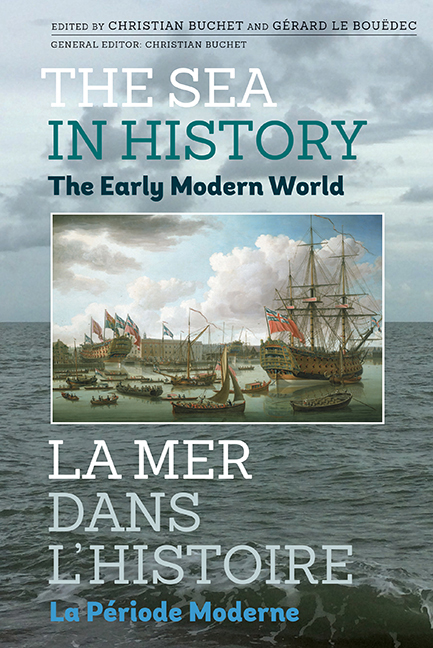Book contents
- Frontmatter
- Contents
- List of Illustrations
- List of Contributors
- Introduction générale et remerciements par
- General introduction and acknowledgements
- Introduction (français)
- Introduction (English)
- LA RÉUSSITE PAR LA MER:La reussite par la mer des territoires et des communautés littorales
- La construction d'un espace mondial: La circulation maritime et les ports
- Les dynamiques des circulations maritimes au XVIIIe siècle entre paix et guerre: ports, circuits, flottes entre logiques étatiques et logiques marchandes
- The European seaport system at the beginning of the early modern age
- Port location and development in the British Atlantic World in the seventeenth and eighteenth centuries
- Mutations et recompositions des flottes marchandes en Méditerranée
- Indian ports and European powers
- African Atlantic ports and trade fleets
- Les ports du Maghreb à l'époque moderne
- La forte croissance de l'économie des pêches et des échanges
- Les acteurs de la dynamique maritime
- LA PUISSANCE MARITIME INSTRUMENT DE LA PUISSANCE POLITIQUE ET D'UNE STRATÉGIE GLOBALE DE RAYONNEMENT VOIRE DE DOMINATION: Les puissances maritimes occidentales
- L'océan Indien, entre convoitises et indifférences
- Les puissances maritimes asiatiques
- L'Afrique
- La politique maritime et l'idéologie
- Mer et développement technologique
- Développement maritime et maîtrise économique et financière
- Développement maritime et maîtrise organisationnelle
- Conclusion (français)
- Conclusion (English)
- Conclusion générale par
- General conclusion by
- Miscellaneous Endmatter
- Miscellaneous Endmatter
Indian ports and European powers
from La construction d'un espace mondial: La circulation maritime et les ports
Published online by Cambridge University Press: 11 May 2017
- Frontmatter
- Contents
- List of Illustrations
- List of Contributors
- Introduction générale et remerciements par
- General introduction and acknowledgements
- Introduction (français)
- Introduction (English)
- LA RÉUSSITE PAR LA MER:La reussite par la mer des territoires et des communautés littorales
- La construction d'un espace mondial: La circulation maritime et les ports
- Les dynamiques des circulations maritimes au XVIIIe siècle entre paix et guerre: ports, circuits, flottes entre logiques étatiques et logiques marchandes
- The European seaport system at the beginning of the early modern age
- Port location and development in the British Atlantic World in the seventeenth and eighteenth centuries
- Mutations et recompositions des flottes marchandes en Méditerranée
- Indian ports and European powers
- African Atlantic ports and trade fleets
- Les ports du Maghreb à l'époque moderne
- La forte croissance de l'économie des pêches et des échanges
- Les acteurs de la dynamique maritime
- LA PUISSANCE MARITIME INSTRUMENT DE LA PUISSANCE POLITIQUE ET D'UNE STRATÉGIE GLOBALE DE RAYONNEMENT VOIRE DE DOMINATION: Les puissances maritimes occidentales
- L'océan Indien, entre convoitises et indifférences
- Les puissances maritimes asiatiques
- L'Afrique
- La politique maritime et l'idéologie
- Mer et développement technologique
- Développement maritime et maîtrise économique et financière
- Développement maritime et maîtrise organisationnelle
- Conclusion (français)
- Conclusion (English)
- Conclusion générale par
- General conclusion by
- Miscellaneous Endmatter
- Miscellaneous Endmatter
Summary
ABSTRACT. The use of force, monopolies, and the Europeans' will to dominate according to three types of structures — the Portuguese royal monopoly, charter companies, and private trade — affected the populations but did not result in a total domination of the Indian Ocean. The Portuguese Cartaz system was never an absolute weapon since the Asian merchants knew how to work around it. The companies were often dependent on the rajas' collaboration. The European powers remained confined in the coastal zones. Nonetheless, these port-cities became great economic centres, in which the local elite found themselves increasingly in an unfavourable power balance, and progressively became bridge-heads for colonial expansion.
RÉSUMÉ. L'usage de la force, des monopoles et de la volonté de domination des Européens selon trois modes opératoires, le monopole royal portugais, les compagnies à charte et le commerce privé, frappèrent certes les populations mais n'aboutirent pas à une domination totale de l'océan Indien. Le Cartaz system des Portugais ne fut jamais une arme absolue car les marchands asiatiques savent s'en accommoder. Les compagnies étaient souvent dépendantes de la collaboration de rajahs. Ces pouvoirs européens restèrent confinés dans les zones littorales. Il n'en demeure pas moins que ces villes-ports, par leur attraction, étaient devenues de grands centres économiques où les élites locales se trouvaient de plus en plus dans un rapport de forces défavorables et constituaient progressivement des têtes de pont pour une expansion coloniale.
The history of maritime India is intricately connected to the history of the Indian Ocean. The south Asian sub-continent has a vast coastline with numerous port cities that emerged and declined due to the natural formation and silting of harbours. Ports of varying sizes rose into prominence and declined due to contingencies like geographic changes, silting, economic decline or lack of political support. Ports were dynamic and porous spaces, where different cultures came into contact, and gateways through which these cultures permeated into hinterlands. For centuries, traders, sailors, soldiers, slaves, migrants, convicts, pilgrims, pirates, mercenaries, rebels and travellers connected ports of south Asia with the Arab world, North and East Africa and Southeast Asia. Indian ports were cosmopolitan trading nexuses of peoples, cultures and ideas and had been home to traders and settlers from the surrounding regions for centuries.
- Type
- Chapter
- Information
- The Sea in History - The Early Modern World , pp. 178 - 188Publisher: Boydell & BrewerPrint publication year: 2017



